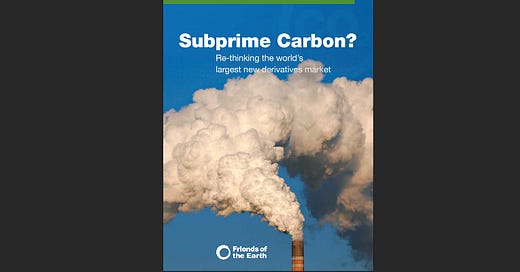“Subprime Carbon?”: New Friends of the Earth report
The carbon trade is a derivatives market which may eventually be bigger than the credit derivatives market which collapsed so spectacularly in the current financial crisis, notes a new report by Friends of the Earth U.S.
Despite this, most proposed climate legislation bills rely on cap-and-trade systems which fail to address the complexities of the carbon market and fail to address carbon trading as a massive new derivatives market. FoE U.S. warns of a “giant regulatory gap”. Regulation of secondary carbon markets, which are far larger than primary markets and are dominated by speculators, is effectively non-existent.
The report, “Subprime Carbon? Re-thinking the world’s largest new derivatives market”, can be downloaded here.
The carbon markets already have all the ingredients for a subprime carbon market, in particular futures contracts to deliver carbon that carry a relatively high risk of not being fulfilled. With offsets projects, sellers can promise to deliver carbon credits before they are actually issued to a project, or before the emissions reductions have been verified. Financial innovation, such as complex securitised products, could spread subprime carbon throughout the financial system.
The report, written by Michelle Chan of FoE U.S., notes that
The buying and selling of carbon (allowances and credits) is fundamentally derivatives trading. Currently, most carbon is sold as futures or forward contracts, a type of derivative. These contracts contain promises to deliver carbon allowances or credits in a certain quantity, at a certain price, by a specified date. Today’s carbon markets are small, but if the United States adopts carbon trading on the scale envisioned by most federal cap-and-trade bills, carbon derivatives will become what Commodities Future Trading Commissioner Bart Chilton predicted would be ‘the biggest of any derivatives product in the next four to five years.’
FoE U.S. calls for regulation of the carbon markets to be explicitly included in the current efforts to reform Wall Street, with measures to prevent the spread of subprime carbon “to ensure the environmental and financial integrity of this emerging, exotic derivatives market”. In particular, FoE U.S. “strongly endorses prohibiting offsets as the best way to prevent subprime carbon” but also recommends proposals which fundamentally re-design carbon markets, setting stable prices and maintaining firm caps.
The report highlights trading in forest carbon as a potential source of subprime carbon:
Subprime carbon can also come from projects that use controversial methodologies to verify a project’s GHG savings. Some offset projects, such as those which seek to protect forests as a means of sequestering carbon, are by nature difficult to verify. For example, even with advances in satellite imaging, it is difficult to verify with accuracy how many tons of GHGs were sequestered by preventing a tract of land from being deforested or degraded.





